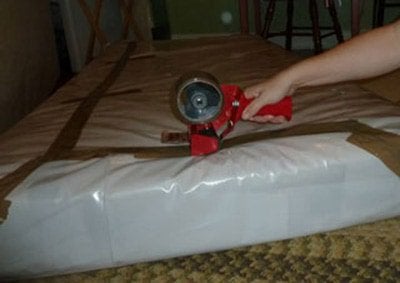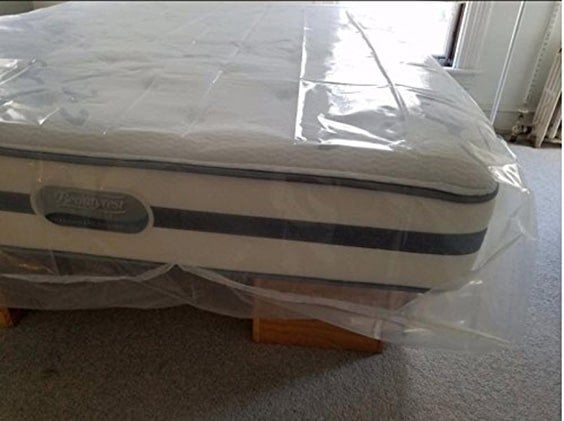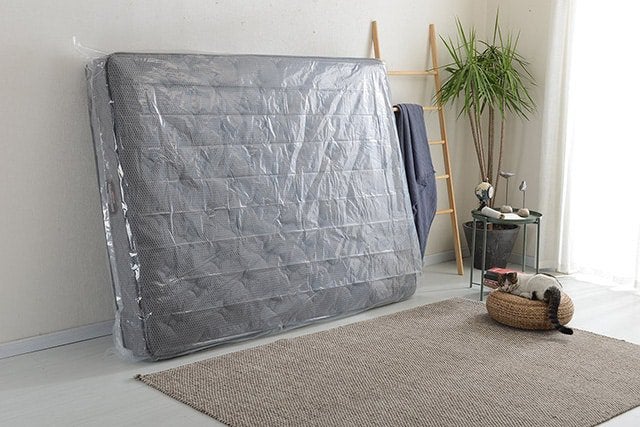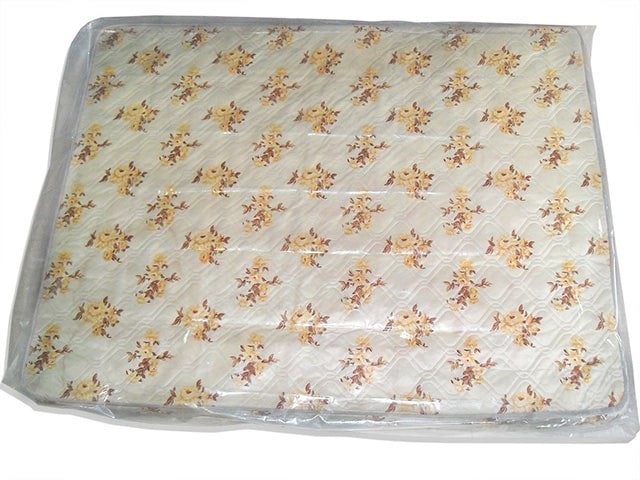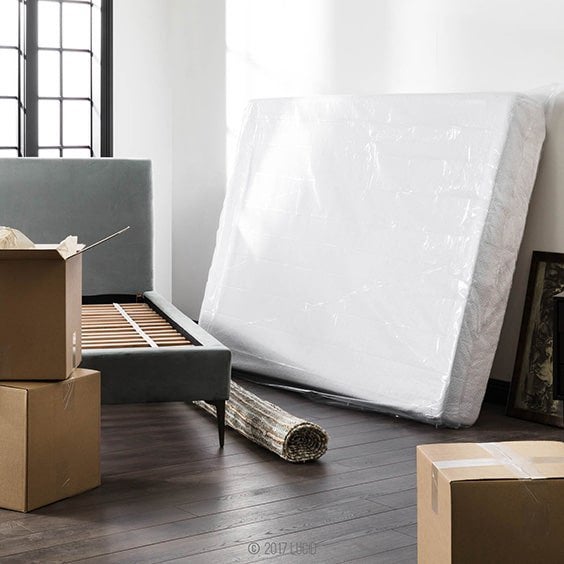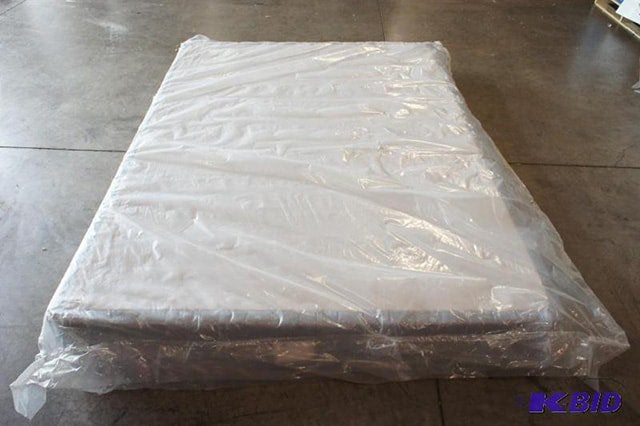There most likely will come a time in your life when you will find the need to store your mattress. Cross-country moves, renovations, or downsizing are all reasons to pack away your belongings with care, and many times your bigger, bulkier items are the first to be packed away. Whether you are putting up your mattress for a temporary short-term time frame, or you need some longer storage options- storing your mattress shouldn’t have to be a daunting task, and the following tips should get you well on your way to keeping it safe and protected for as long as you need it to be.
What You Need:
- Durable plastic sheets
- Packing tape
Optional:
- Waterproof mattress cover
Steps for Storing a Mattress:
Step 1: Clean Your Mattress Well


Mattresses are notorious for collecting dust mites and other allergens in the many small seams, cracks, and crevices along the tops and sides of the product. Even with the best cleaning schedule, these can accumulate quite quickly, especially if you have any pets in the house. Prior to storing, be sure to give your mattress a good, thorough cleaning and airing out to ensure it is dry, and fresh prior to putting it away for any length of time. This will ensure you have anything you wouldn’t want to be trapped in it during the time it is in storage.
What to Remember: If you use any liquids through this process, be sure it is well dried before continuing to step 2.
Step 2: Wrap Your Mattress in Plastic
One of the greatest threats to the integrity of your mattress is moisture and staining. To keep your mattress surface from coming into contact with anything unexpected while in storage, you’ll want to wrap it in thick durable plastic sheets and tape them down securely. Rather than getting a few smaller sheets, try getting a large sheet that you can fold around your mattress and tuck in before taping to provide extra layers along the edges and corners- the spots most likely to bump against things and wear while being transported.
What to Remember: Be sure to wrap your tape and reinforce it to ensure that it has truly bound the tape to the mattress. Don’t skimp on tape quality either. Cheap tape may begin to dry out and pull away over long periods of time
Step 3: Keep Your Mattress Flat
Mattresses are constructed to lay flat and uphold weight no matter what materials are being used. Although many sites may claim that storing your mattress on its side is the easiest and most convenient way to store it- it honestly is not always the best advice. Remember, mattresses are typically a pretty heavy product, and all that foam, padding, and/or coils will begin to sink into gravity. Once this happens your mattress may never be the same again. If you must store it on its side, try to do so only for short periods of time, otherwise, you find a flat surface upon which to lay it down.
What to Remember: If side storage is your only option, and could be for a longer length of time, try to rotate the mattress every few months from side-to-side and head-to-foot to apply even wear of the weight of the material.
Step 4: Do Not Stack Other Objects Upon Your Mattress
Even though mattresses are made to lay upon, even with nightly use it is suggested to rotate your mattress every 3 to 4 months to keep it wearing evenly. The reason behind this is due to how materials settle over time and compress under your body weight. This is especially true if you sleep with a particularly sized partner. The same concept applies to placing weight upon it when in storage. When you do this, it becomes a continual pressure that never allows the material to rest and, coincidentally, will result in less mattress life in the long run. Mattresses will compress naturally under your weight over time, so it’s best if you don’t speed up this process.
What to Remember: Because mattresses are large and take up a lot of room when laid flat, if you are worried about storage space for all your items, try to place your mattress on top of your flat boxes. You may even consider investing in a cheap plywood board to rest on top of your boxes to place your mattress on to keep it lasting for years to come once it’s time to remove it from storage.
OPTIONAL Step 5: Consider the Addition of a Waterproof Mattress Storage Cover
Depending on the length of time you plan on storing your mattress, you may want to apply an additional mattress cover or encasement. This is especially true if you need to plan for longer periods of time to provide peace of mind. Even the best-wrapped plastic may allow fine dirt and dust in overtime through small cracks and folds. The addition of another layer will help provide extra protection that will keep fine dust and dirt from getting too far into any available openings. When placed over a wrapped mattress, it also helps keep your plastic in place and snug up against the mattress itself and also keeps any tape that may have not quite sealed well from peeling back and exposing your material.
What to Remember: Where you choose to store your mattress is also very important, as I’ll explain below, but this extra cover may be what you need if you are limited in storage choices. This is also good for extra protection during transportation.
Step 6: Apply Climate Control
The biggest threat to your mattress is going to be humidity and mildew. Always make sure you wrap your mattress when you know it is dry in order to keep from trapping any moisture within. But you also need to take care of where you store it and should check out storage areas prior to placing your mattress in storage for any length of time to assure yourself of it staying dry. If possible, store it in a temperature controlled storage unit, or within the house rather than the garage, attic, or basement if dampness is an issue where you live. Or place a dehumidifier within the same space to help keep humidity and dampness from causing an issue.
What to Remember: A tightly wrapped and protected mattress will keep moisture from seeping in, but certain materials are more prone and less breathable than others – such as memory foam. Be sure to take extra precaution to keep mattress that has memory foam, or other types of foam, dry.
Step 7: Move in a Covered Vehicle
If you are moving your mattress to a storage area, then be sure to transport it within a covered vehicle to avoid compromising the awesome wrapping job you applied. This also helps to keep it from getting inadvertently exposed to moisture or other dirt, liquids, or sharp objects.
What to Remember: If you must transport it in the open, consider protecting it even further with the added mattress protector.
Step 8: Apply the Same Methods to Your Box Spring
If you happen to have a boxspring, simply apply the same methods as described above prior to storage to keep it protected an useful in the future. Box springs are definitely worth keeping around, even if you have a platform bed frame, as they can help raise the mattress it belongs to in case you need the added height.
Step 9: Allow to Air Out Before Use
No matter how long you’ve had your mattress in storage, you’ll want to air it out well before use. If possible, allow it to sit in the sun for a few hours as the UV rays will kill off any lingering allergens and help refresh the material. Sprinkling baking soda over it will also help draw any smells that may have seeped into the fabric while in storage and help it smelling fresh and new in no time. If you have to store for long periods of time and happen to have access to storage, you may want to air it out every 6 months or so. Doing so allows for any trapped stale air to escape and keep from making your mattress become too ‘stuffy’ smelling.
Conclusion
Chances are the time will come when you will want to store your mattress for a period of time either through a move or change in decor or home renovation. Mattresses are an expensive investment, both financially as well as for personal comfort preferences. If you have a mattress that works well for your body type, then you most likely want to hold onto it for as long as you can. Storing a mattress truly is an easy task. Even though you should keep it flat for the time you need it stored for, if you have to store it upright, it’s not difficult to care for it correctly to keep from compromising the mattress structure. Making sure it is well wrapped, securely taped, and put in a place where temperature fluctuations will not cause large amounts of humidity or dampness is all you really need to consider.

